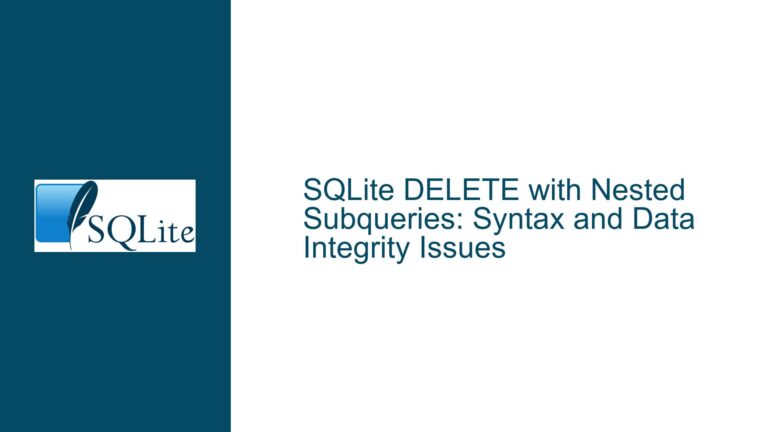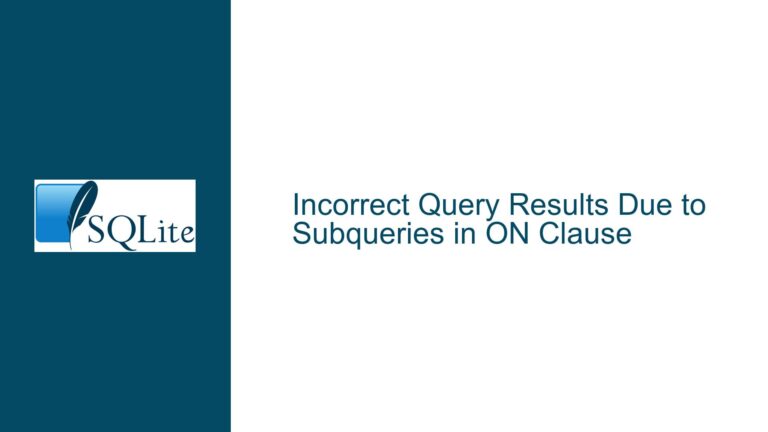IPv6 Standard Form Query in SQLite
Understanding IPv6 Representation in SQLite
The representation of IPv6 addresses in SQLite can be complex, particularly when dealing with the conversion of binary data types into human-readable formats. The core issue arises when users attempt to visualize IPv6 addresses stored as blobs, especially when they include CIDR notation. The challenge is to convert the hexadecimal representation of these addresses into a standard textual format that is both canonical and easily interpretable.
IPv6 addresses are typically stored in a binary format within SQLite, specifically as blobs. This format allows for efficient storage and manipulation but poses challenges for users who need to convert these addresses back into a standard text representation. The standard form of an IPv6 address consists of eight groups of four hexadecimal digits, separated by colons. When CIDR notation is involved, a suffix indicating the prefix length follows the address.
For example, an IPv6 address such as 2001:0db8:85a3:0000:0000:8a2e:0370:7334 may be stored in a blob format, which complicates direct querying and visualization. Users often find themselves needing to extract specific components from this binary representation to achieve the desired output.
Identifying Challenges in Conversion
Several challenges can arise when attempting to convert IPv6 blob data into its standard textual form. These challenges include:
Length Variability: IPv6 addresses can vary in length depending on whether they include a CIDR suffix. For instance, an address with a CIDR notation may have an additional byte representing the prefix length, leading to potential discrepancies during conversion.
Hexadecimal to Decimal Conversion: A significant challenge is converting specific hexadecimal digits into their decimal equivalents, particularly when dealing with the CIDR suffix. Standard SQLite functions do not provide direct methods for this conversion, necessitating workarounds.
Blob Affinity Handling: The way SQLite handles blob data types can lead to complications when querying and manipulating IP addresses. Users must be aware of how to properly assess the type and length of the blob data before proceeding with conversions.
Lack of Built-in Functions: Unlike some other database systems, SQLite does not come equipped with built-in functions specifically designed for handling IP address formats. Users must either create custom functions or rely on complex SQL queries to achieve their goals.
These challenges necessitate a thorough understanding of both the structure of IPv6 addresses and the capabilities of SQLite’s SQL syntax.
Step-by-Step Troubleshooting Guide
To effectively troubleshoot and resolve issues related to converting IPv6 blob data into standard text form in SQLite, follow these detailed steps:
Step 1: Assess Blob Data Structure
Before attempting any conversions, it is crucial to understand the structure of the blob data representing the IPv6 address.
Identify Length: Determine whether the blob length is 16 bytes (standard IPv6) or 17 bytes (IPv6 with CIDR). This can be done using the
length(ip)function in SQL.Check Type: Ensure that the data type is indeed a blob by using
typeof(ip). This step prevents errors that could arise from attempting conversions on incompatible data types.
Step 2: Construct Hexadecimal Representation
Once you have confirmed that you are working with a blob containing an IPv6 address, construct its hexadecimal representation.
Use the
hex(ip)function to obtain the hexadecimal string equivalent of the blob.This string will be used for further manipulation and conversion into standard text form.
Step 3: Format IPv6 Address
With the hexadecimal representation at hand, proceed to format it into the standard textual form.
Split the hexadecimal string into groups of four characters each, representing each segment of the IPv6 address.
Use
substr(hex(ip), start_index, length)to extract each segment based on its position within the hexadecimal string.
Step 4: Handle CIDR Notation
If your IPv6 address includes a CIDR suffix (indicated by an additional byte), you will need to extract and convert this byte as well.
For a 17-byte blob, extract the last byte using
substr(hex(ip), 33), which corresponds to the position in the hex string where this byte appears.Convert this hex value into decimal using a combination of string manipulation functions such as
instr()to find its position within a predefined string of hex digits (e.g., ‘0123456789ABCDEF’).
Step 5: Assemble Final Output
Finally, concatenate all components together to form the complete standard form of the IPv6 address.
Use
||operator in SQL to concatenate strings.Ensure that you correctly append any CIDR notation if applicable by checking if the length of
ipequals 17 before adding it to your final output string.
Example Query Implementation
Here’s how you can implement these steps in an SQL query:
CREATE VIEW "type_INET+" AS
SELECT *,
case
when typeof(ip) = 'blob' and (length(ip) = 16 or length(ip) = 17) then
lower(
substr(hex(ip),1,4) || ':' ||
substr(hex(ip),5,4) || ':' ||
substr(hex(ip),9,4) || ':' ||
substr(hex(ip),13,4) || ':' ||
substr(hex(ip),17,4) || ':' ||
substr(hex(ip),21,4) || ':' ||
substr(hex(ip),25,4) || ':' ||
substr(hex(ip),29,4)
) ||
case
when length(ip) = 17 then
'/' || ((instr('123456789ABCDEF', substr(hex(ip),33,1)) << 4) + instr('123456789ABCDEF', substr(hex(ip),34,1)))
else ''
end
when typeof(ip) = 'blob' and (length(ip) = 4 or length(ip) = 5) then
-- Handle IPv4 conversion similarly
else null
end as ip_text
FROM "type_INET";
This query effectively converts both IPv6 addresses stored as blobs and those with CIDR notation into their respective standard forms while handling potential pitfalls along the way.
By following these steps and understanding each component’s role in converting IPv6 addresses within SQLite, users can successfully visualize their IP data without resorting to external functions or complex programming solutions.






